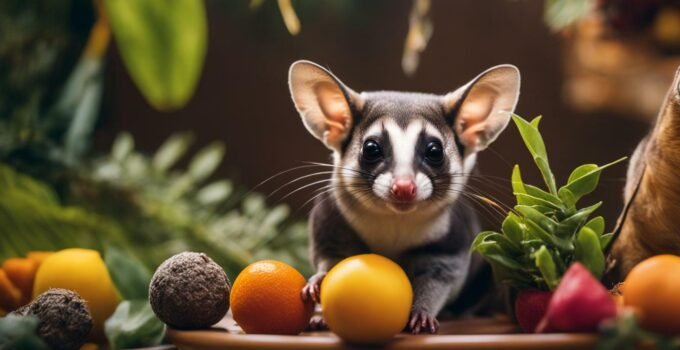Sugar gliders are unique marsupials that make fascinating pets, but they require specific care to ensure their health and happiness. Native to Australia and Indonesia, these social animals thrive in pairs or colonies and form strong bonds with their owners. Providing proper care, nutrition, and handling is essential for their well-being.
Key Takeaways:
- Sugar gliders are social animals and do best in pairs or colonies.
- Bonding with your glider is important, consider wearing fleece squares with your scent.
- Find a veterinarian who specializes in exotic animals for regular check-ups and emergency care.
- Common health issues in sugar gliders include calcium deficiency, constipation or diarrhea, injury, parasites, and stress.
- Provide a spacious cage with room for climbing and gliding, and plenty of toys for enrichment.
Understanding Sugar Gliders: Behavior and Needs
When bringing a sugar glider into your home as a pet, it’s important to understand their behavior and meet their unique needs. Sugar gliders are social animals that thrive on companionship, both with other gliders and their human owners. Bonding with your sugar glider is crucial, as it helps establish trust and a strong relationship.
Enrichment is key to keeping your sugar glider happy and stimulated. These small marsupials are highly active and require plenty of mental and physical exercise. Providing them with a variety of toys, climbing structures, and opportunities to explore their environment will help prevent boredom and promote their overall well-being.
Grooming is another important aspect of sugar glider care. These adorable creatures are known for their meticulous grooming habits, often taking time to groom themselves and their companions. Regularly checking their fur for any signs of matting or parasites, and providing them with safe materials like branches or dish of water for bathing, will help keep them clean and healthy.
Creating a Suitable Habitat: Cage and Housing
Creating a suitable habitat is essential for providing your sugar glider with a comfortable and safe living environment. When it comes to housing, there are a few key factors to consider, including cage size, suitable materials, and how to make it glider-proof.
Cage Size
When selecting a cage for your sugar glider, it’s important to choose one that provides enough space for them to move around and exercise. A minimum cage size of 24 inches by 24 inches is recommended, but bigger is always better. Opt for a cage with multiple levels and plenty of room for climbing and jumping. Remember, sugar gliders are highly active and need space to explore and exercise.
Suitable Materials
When it comes to the materials used in the cage, it’s essential to select ones that are safe for your sugar glider. Avoid cages made of materials like galvanized metal, as the gliders can chew on it, leading to potential health issues. Instead, opt for cages made of stainless steel or powder-coated wire, as these are non-toxic and easy to clean.
Glider-Proofing
Sugar gliders are curious creatures and can easily escape from a poorly secured cage. To ensure your gliders stay safe and secure, it’s important to glider-proof the cage. Check for any small openings that your glider could squeeze through and make sure all doors and latches are secure. Additionally, remove any potential hazards such as toxic plants, electrical cords, or small objects that could be ingested.
By providing a suitable habitat, including a properly sized and secure cage, you can create a comfortable and safe living environment for your sugar glider. Remember, gliders are social creatures and require stimulation and interaction, so be sure to include plenty of toys and enrichment activities in their habitat.
| Benefits of a Suitable Habitat |
|---|
| Provides space for exercise and exploration |
| Ensures safety and prevents escape |
| Promotes a comfortable and stress-free environment |
| Allows for the inclusion of toys and enrichment activities |
Feeding a Balanced Diet: Nutrition and Supplements
Proper nutrition is essential for the health and well-being of your sugar glider. These small creatures have specific dietary requirements that must be met to ensure their optimal growth and development. A balanced diet for a sugar glider includes a combination of fresh fruits, vegetables, proteins, and supplements. By understanding their nutritional needs, you can provide your pet with a well-rounded diet that promotes their overall health.
Sugar gliders are omnivores and require a variety of foods to thrive. Their diet should consist of high-quality produce, such as apples, oranges, grapes, carrots, leafy greens, and sweet potatoes. These fruits and vegetables provide essential vitamins, minerals, and fiber that support their digestive system and strengthen their immune system. It’s important to offer a diverse range of produce to ensure they receive a wide array of nutrients.
In addition to fruits and vegetables, sugar gliders also require a source of protein in their diet. This can be in the form of insects, such as mealworms or crickets, or a commercial sugar glider food that contains adequate levels of protein. Protein is crucial for their growth, muscle development, and overall energy levels. It’s important to note that sugar gliders have higher protein requirements compared to other small mammals, so it’s essential to ensure they receive enough protein in their diet.
| Recommended Protein Sources | Frequency |
|---|---|
| Insects (mealworms, crickets) | 2-3 times per week |
| Commercial sugar glider food | Daily |
In addition to their primary diet, sugar gliders may benefit from certain supplements to ensure they receive all the necessary vitamins and minerals. Calcium and vitamin D3 supplementation is crucial for their bone health, as these nutrients help prevent metabolic bone disease. It’s important to consult with a veterinarian who specializes in exotic animals to determine the appropriate supplementation for your sugar glider.
Remember to always provide fresh food and clean drinking water for your sugar glider. Regularly monitor their diet and adjust accordingly to meet their changing nutritional needs. By providing a balanced diet rich in fruits, vegetables, and proteins, along with the necessary supplements, you can ensure your sugar glider remains healthy and happy.
Veterinary Care: Finding an Exotic Animal Specialist
When it comes to caring for your sugar glider, finding a veterinarian who specializes in exotic animals is crucial. These unique creatures require specialized care and medical attention to ensure their health and well-being. Regular check-ups with a knowledgeable veterinarian will help you catch any potential health issues early on and provide the necessary treatment.
Your sugar glider is more than just a pet; they are a companion. Just like any other companion, they deserve the best possible care. To find a reputable exotic animal specialist, start by asking for recommendations from other sugar glider owners or local exotic pet organizations. These sources can provide valuable insights into veterinarians who have experience working with sugar gliders and can be trusted to provide high-quality care.
When selecting a veterinarian for your sugar glider, consider their expertise, credentials, and experience handling these unique animals. Look for a veterinarian who is knowledgeable about sugar glider behavior, nutrition, and common health issues. They should be able to provide guidance on proper diet and nutrition, as well as offer advice on handling and bonding techniques.
| Veterinarian Checklist | Questions to Ask |
|---|---|
| Experience with sugar gliders | Have you treated sugar gliders before? How frequently do you see them in your practice? |
| Specialized knowledge | What is your understanding of sugar glider behavior, diet, and common health issues? |
| Emergency care availability | What are your emergency care services? Do you have after-hours availability? |
| Support network | Do you have access to other exotic animal specialists or resources for consultation? |
Regular check-ups are essential for monitoring your sugar glider’s overall health and early detection of any potential health concerns. By finding a veterinarian who specializes in exotic animals and building a trusting relationship with them, you can provide the best possible care for your sugar glider companion.
Handling and Bonding: Building a Trusting Relationship
Handling and bonding with your sugar glider is crucial for building a trusting and close relationship. These small marsupials require gentle and patient handling to ensure their emotional well-being. By following some essential tips, you can create a positive and secure environment for both you and your sugar glider.
Creating a calm and familiar environment
When handling your sugar glider, it’s important to choose a quiet and secure area where they feel safe. Avoid loud noises and sudden movements that may startle them. Make sure the room is glider-proofed, removing any potential hazards that could harm your pet. Providing a familiar environment will help your sugar glider feel more comfortable and at ease.
Using scent to establish trust
Sugar gliders have a keen sense of smell and use scent to recognize familiar individuals. To bond with your pet, consider wearing a piece of clothing or placing a soft cloth in your sugar glider’s sleeping area. This will help transfer your scent to them, promoting familiarity and trust. Remember to be patient, as it may take time for your glider to associate your scent with safety and comfort.
“Building a strong bond with your sugar glider is vital for their well-being and overall happiness. Take the time to establish trust by creating a calm environment and using scent to build familiarity. Remember, patience and gentle handling are key.”
– Dr. Emily Peterson, Exotic Animal Specialist
Practice gentle handling techniques, using a cupped hand to support your sugar glider’s body and allowing them to climb onto your hand voluntarily. Avoid grabbing or squeezing, as this can cause stress and discomfort. Gradually increase the duration and frequency of handling sessions as your sugar glider becomes more comfortable.
Building trust through bonding activities
Bonding activities such as pouch time and playtime outside the cage are important for developing a strong relationship with your sugar glider. Pouch time involves carrying your glider in a bonding pouch close to your body, allowing them to feel your warmth and heartbeat. This activity helps foster a sense of security and closeness. Playtime outside the cage provides an opportunity for interaction and exploration, reinforcing the bond between you and your pet.
Remember, every sugar glider is unique, and building trust may take time. Be patient, consistent, and respectful of your pet’s boundaries. With dedication and love, you can develop a deep bond with your sugar glider that will last a lifetime.
Promoting Physical and Mental Health: Enrichment and Exercise
Ensuring the physical and mental well-being of your sugar glider is essential for their overall health and happiness. In addition to providing a suitable habitat and nutritious diet, incorporating enrichment activities and exercise into their daily routine is key. By stimulating their natural instincts and keeping them active, you can help prevent boredom, promote healthy behaviors, and strengthen your bond with your furry companion.
Enrichment Activities
Sugar gliders are highly intelligent and curious animals that thrive on mental stimulation. Providing a variety of enrichment activities will engage their minds and prevent boredom. Consider introducing puzzle toys, hanging branches for climbing and exploration, and treat-dispensing toys to encourage foraging behaviors. You can also create a glider-safe play area outside their cage, allowing them to explore their surroundings under your supervision.
Exercise Opportunities
Sugar gliders are active animals that require exercise to maintain their physical health. It’s important to provide opportunities for them to move and play. Set up an exercise wheel inside their cage, ensuring it is the appropriate size and design for sugar gliders. Additionally, create a glider-safe environment outside the cage, where they can glide and climb while supervised. Remember that sugar gliders are arboreal creatures, so offering vertical space with branches and ropes will encourage natural behaviors.
| Enrichment Ideas | Exercise Tips |
|---|---|
|
|
By providing a stimulating environment and ample opportunities for exercise, you can contribute to your sugar glider’s physical and mental well-being. Remember to observe their behaviors and adjust their enrichment and exercise routines accordingly, offering new challenges and ensuring their safety at all times. A healthy and happy sugar glider will reward you with their playful and affectionate nature.
Common Health Issues and Prevention: What to Watch for
As a responsible sugar glider owner, it is important to be aware of common health issues that your furry friend may encounter. Regular check-ups with an experienced exotic animal veterinarian are crucial for maintaining the well-being of your sugar glider. By staying vigilant and observing any changes in behavior or appearance, you can catch potential health concerns early on. Here are some key health issues to watch out for:
Parasites
Sugar gliders can be susceptible to various parasites, including external parasites like mites and ticks, as well as internal parasites such as worms. Regularly inspecting your sugar glider’s fur and skin for any signs of itching, redness, or irritation can help you detect and address parasitic infestations promptly. Your veterinarian can recommend appropriate treatments and preventive measures to keep your sugar glider parasite-free.
Stress
Sugar gliders are sensitive creatures that can experience stress due to changes in their environment or routine. Stress can weaken their immune system and make them more prone to illness. It is important to provide a stable and stimulating environment for your sugar glider, ensuring they have plenty of social interaction, mental stimulation, and a consistent daily routine. Additionally, avoiding sudden changes or disruptions in their environment can help minimize stress and promote their overall well-being.
Recognizing Signs of Illness
It is crucial to familiarize yourself with the common signs of illness in sugar gliders, as they may hide their symptoms until they are severely ill. Look out for changes in appetite, weight loss, lethargy, abnormal droppings, respiratory distress, or any unusual behaviors. If you notice any of these signs, it is important to consult with your veterinarian as soon as possible. Early detection and treatment can greatly improve the chances of a successful recovery.
| Common Health Issues | Prevention |
|---|---|
| Parasites (mites, ticks, worms) | Regular check-ups, preventive treatments |
| Stress-related illnesses | Providing a stable environment, mental stimulation |
| Respiratory infections | Maintaining clean and well-ventilated habitat |
| Nutritional deficiencies | Feeding a balanced diet and appropriate supplements |
By being proactive in monitoring your sugar glider’s health, addressing potential issues promptly, and providing the necessary preventive care, you can ensure that your furry friend leads a long and healthy life.
Conclusion
In conclusion, caring for a sugar glider as a pet requires attention to their unique needs and behaviors. Providing a suitable habitat with the right cage size and materials is crucial for their well-being. Ensuring a balanced diet rich in fruits, vegetables, and proteins, along with the necessary supplements, is essential for their nutrition.
Regular veterinary care from an exotic animal specialist is important for maintaining the health of your sugar glider. Building a trusting relationship through gentle handling techniques, bonding, and creating a stimulating environment with toys and exercise opportunities is key to their physical and mental well-being.
Finally, being aware of common health issues, their prevention, and recognizing signs of illness are vital for their overall health. By following these guidelines, you can ensure that your sugar glider lives a happy and healthy life as your companion.
FAQ
Can sugar gliders be kept alone?
No, sugar gliders are social animals and should not be kept alone. They thrive in pairs or colonies.
How can I bond with my sugar glider?
To bond with your sugar glider, wear fleece squares with your scent to help them become familiar with you. Spend time interacting with them and providing gentle, positive experiences.
What should I feed my sugar glider?
A balanced diet for sugar gliders includes fruits, vegetables, and proteins. Avoid feeding them harmful foods such as raw sugar, candy, or chocolate.
How often should I take my sugar glider to the vet?
It is important to find a veterinarian who specializes in exotic animals for regular check-ups and emergency care. Schedule regular visits and seek medical attention if your glider shows signs of illness or injury.
What are common illnesses in sugar gliders?
Common illnesses in sugar gliders include calcium deficiency, constipation or diarrhea, injury, parasites, and stress. Regular vet check-ups and a proper diet can help prevent these issues.
What kind of cage should I provide for my sugar glider?
Sugar gliders need a spacious cage with plenty of room for climbing and gliding. Use wire mesh or metal bars with small spacing to prevent escaping. Include food dishes, a nesting area, and toys for enrichment.
How can I promote the physical and mental health of my sugar glider?
Provide a stimulating environment with toys, climbing structures, and opportunities for exercise. Avoid taking your glider outside without supervision and be cautious of other pets and loud noises.
What should I watch for in terms of my sugar glider’s health?
Watch for signs of illness, such as changes in appetite, weight loss, lethargy, or unusual behavior. Regularly clean the cage and monitor for any signs of injury, parasites, or stress.



